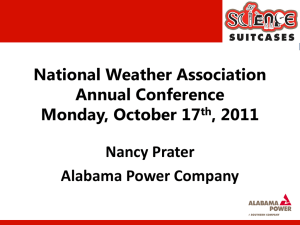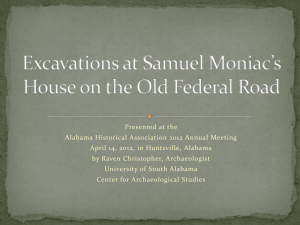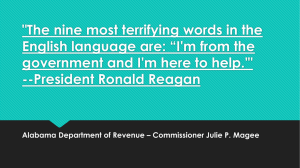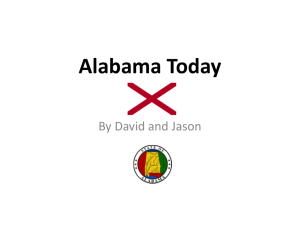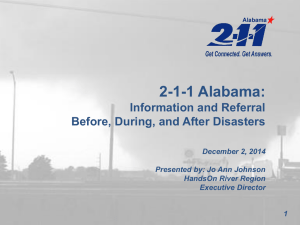Alabama First Responder Wireless Commission
advertisement
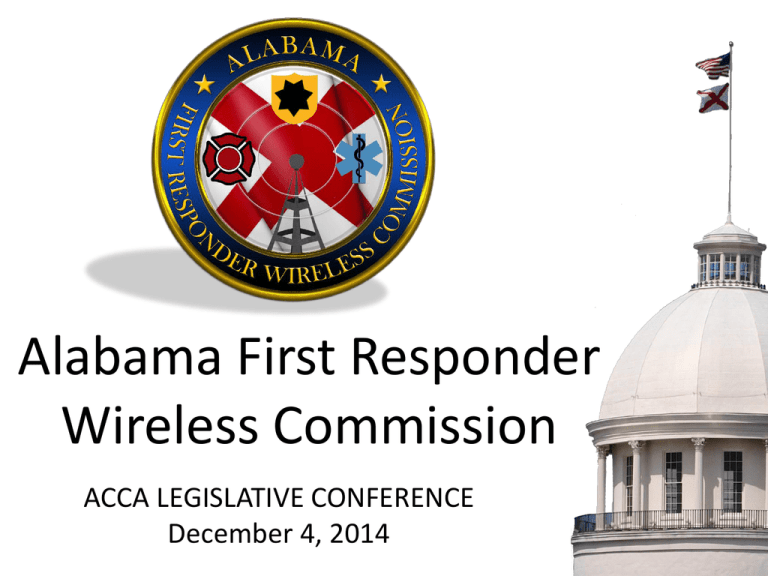
Alabama First Responder Wireless Commission ACCA LEGISLATIVE CONFERENCE December 4, 2014 Executive Order 34 • • • • • Before Executive Order 34, no one body was tasked to work towards a resolution to the state’s first responder communication problems. This executive order created a commission in 2012 that focused on how to best meet the communication needs of all first responders across the state. Federal, State, Local & Tribal jurisdictions currently operate numerous disparate communication systems that cover the same area. State communication infrastructure (towers, microwave, shelters, etc.) is limited and in most cases will not facilitate additional equipment to provide public safety grade communications. Required ALL state agencies to work together for the common goal. ACT 2013-330 • Act 2013-330 (House Bill 92), codified the Governor’s Executive Order 34 and permanently created the Alabama First Responder Wireless Commission. • The AFRWC is comprised of 28 commissioners representing State, County, and Municipal first responders from Law, Fire, EMA, EMS and other disciplines. Commission Membership • • • • • • • • • • • • • • • The Secretary of the Alabama State Law Enforcement Agency; The Director of the Alabama Emergency Management Agency; The Director of the Alabama Department of Public Safety; The Director of the Alabama Department of Transportation; The Adjutant General of the Alabama National Guard; The Commissioner of the Alabama Department of Conservation and Natural Resources; The Director of the Alabama Department of Corrections; The Director of the Alabama Department of Finance (CIO); The State Wide Interoperability Coordinator; The Commissioner of the Alabama Forestry Commission; The Director of the Alabama Department of Public Health; The Director of the Alcoholic Beverage Control; The Director of the Alabama Dept. of Economic and Community Affairs; The Alabama Fire Marshall; The Commissioner of Alabama AG & Industries; • • • • • • • • • • • • • A representative as appointed by the Alabama Sheriffs Association; A representative as appointed by the Alabama Association of Volunteer Fire Departments; A representative as appointed by the Alabama Association of Rescue Squads; A representative as appointed by the Alabama Association of Chiefs of Police; A representative as appointed by the Alabama Association of Emergency Managers; A representative as appointed by the Alabama Association of Fire Chiefs; The Chairperson of the Federal Communications Commission’s Region 1, 700MHz Regional Planning Committee; A representative of the Poarch Creek Band of Creek Indians; A representative as appointed by the National Emergency Number Association of Alabama; A representative as appointed by the Alabama Association of 911 Districts; A representative as appointed by the ACCA; A representative as appointed by the AL League of Municipalities; and A representative as appointed by the Governor. So now what? • Act 2013-330 (HB92) gave the appropriate authority to begin addressing deficiencies relating to communications for our First Responders. • It also provided the governance structure needed to bring all the relevant players to the table from both state and local response agencies. • Most of all, it provided a unified approach that did not alienate local input into a statewide solution. Commission’s Vision The Alabama First Responder Wireless Commission’s (AFRWC) vision is to strengthen public safety emergency communications and interoperability and to create a unified and integrated voice/data communications platform, with the technology, equipment, and procedures necessary to allow first responder and public safety agencies at the State, County, Tribal, and Municipal levels to communicate to safely, effectively, and efficiently to protect the people of Alabama. Mission Statement The mission of the AFRWC is to establish and sustain innovative and consensus-based approaches to missioncritical wireless communications technology and interagency partnerships that lead to seamless communications among public safety agencies serving the citizens of Alabama. Responsibilities of the Commission include: • Strategic planning of public safety spectrum and serving as the intergovernmental bridge between Federal, State, Local, Tribal and private entities to foster and promote collaboration and information sharing • Promoting the efficient use of public resources to ensure that essential public safety personnel have effective communications • Planning, building, implementing and maintaining radio access networks and their application in public safety, public health, and public works AFRWC Workgroups • The AFRWC has created workgroups to assist the commission in meeting it’s goals and objectives: – Project 25 System Administrators Workgroup – State Agencies Workgroup – Users Workgroup • Comprised of our 7 Divisional Advisory Committee (DAC) Chairpersons. – Policies and Procedures Workgroup Life and Safety Issue • Alabama does not have a unified communications system, thus creating the inability for First Responders to communicate with each other on emergency scenes or during disasters. • Alabama currently funds disparate communication systems for ADPS, AEMA, Alabama Forestry, AL DOT, ADOC, and other agencies. • None of the current systems are capable of serving our First Responder’s needs statewide. • The state’s current communication systems are based on antiquated technology. Coverage areas for existing state owned systems is extremely limited. – This lack of coverage presents an ever growing safety issue for our responders. Solution • Move to a unified statewide communication platform. • Use open standards architecture (Project 25) to build a system that all first responder agencies can utilize. • The Legislature should fund one unified system rather than multiple disparate systems. – Funding should be broken into two separate investments: capital improvements and sustainability of a 10-year period. • Capitalize on existing taxpayer investments at the local level by partnering with those jurisdictions that have already built Project 25 systems. This would save taxpayers millions. • Upgrade state infrastructure by building towers, deploying microwave for backhaul connectivity, and laying fiber optic cable. Integrated School Safety • A radio in every school office will allow for schools to send an emergency alert signal to your local law enforcement should a life threatening emergency exist. • The radio is designed to be like a “fire alarm” for police and would be dedicated for this purpose. • Once activated, law enforcement would be able to communicate directly with school officials while enroute. Alabama’s Project 25 Systems coverage So how do we do it? • By creating a strong governance structure (AFRWC), we laid the foundation to be successful. • Local jurisdictions have already started acquiring the necessary infrastructure for a statewide unified communications system. By partnering with them, the state will save millions. • Madison, Morgan, Jefferson, Etowah, Calhoun, Talladega, Shelby, Montgomery, Baldwin, Mobile Counties along with Opelika, Dothan, Northport, and the University of Alabama all have the equipment needed to start the process. • Utilizing the AFRWC, legal documents and agreements are being drafted to share system resources and infrastructure to begin the build out should the Legislature provide funding. • The only piece missing is the state’s contribution. – The state has no “skin-in-the-game”. We have not allocated any funding toward the projects. So how do we do it? (cont) • The commission is working with the system administrators to bring state responders and support personnel onto the systems. • The commission will need $180 million to build a statewide solution for all first responders. • We anticipate a phased approach. – Two ideas is to cover all major highways (Interstates and US hwys) first. Then go back and fill in dead spots. Or – Utilize the geographical divisions as defined by AEMA, ADPS and ALEA, building one region at a time. Once Completed… • Once completed, we would have a unified system-ofsystems both owned and operated by AFRWC and those locals already operating systems. • All first responders and support personnel would have access to a public safety grade communications system. • State agencies (ALEA, ADPS, AEMA, ALDOT, ADCNR, ADOC), County, and Local responders would all work off the same unified system. • The unified system would save lives and give our first responders security knowing that when they use their radio, somebody will answer them. – That can’t be said today… Near-Term Actions • AFRWC partner with existing Local system owners. • Educate the Legislature and garner their support of the project. • Identify $180 million in funding to provide all (Local, County, and State) first responders radio coverage statewide. • Provide funding for a 10 year (long-term) maintenance contract with awarded vendor. Overview of FirstNet and the National Public Safety Broadband Network (NPSBN) FirstNet • Data Communications (not Voice) for First Responders – The state’s POC is Secretary Collier and Chuck Murph is working lead on the program. – The first face-to-face meeting with FirstNet is slated for early 2015 to begin our consultation process. – Once a state plan is drafted by FirstNet, the Alabama First Responder Wireless Commission will make a formal recommendation to the Governor. Chuck Murph Alabama Law Enforcement Agency Cell: 334-328-6848 chuck.murph@alea.gov


